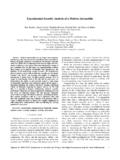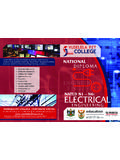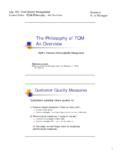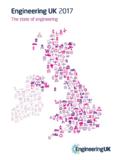Transcription of CHEMISTRY 107 General Chemistry for Engineering …
1 CHEMISTRY 107 general chemistry for engineering students Fall 2018 Sections 501 & 502 Section 501: MWF, 9:10 10:00 AM, HELD 100 Section 502: MWF, 11:30 12:20 PM, HELD 100 Instructor: Dr. Larry Brown Office: 104B Heldenfels (Enter through door marked 104, next to the elevator.) Office Hours: Monday, Wednesday, Friday, ~10:15 11:15 AM (between my 2 lectures) Monday, 1:00 2:30 PM Tuesday, 2:00 3:30 PM Phone: 845-3755 E-mail: Website: Course Objectives This course is intended to provide Engineering students with a background in important concepts and principles of CHEMISTRY . (A few non- Engineering majors, including physics and geophysics, also require this course.) Emphasis will be placed on those areas considered most relevant in an Engineering context, and practical applications in Engineering and technology will be examined.
2 In designing this course, we considered various reasons why Engineering students should learn CHEMISTRY , and tried to express them as specific learning objectives. Many of these objectives deal with particular topics or skills, and a detailed listing can be found online at Some of the most important goals, though, are more global in nature. These goals deal with the overall relationship between CHEMISTRY (or science in General ) and Engineering rather than with the details of any particular chemical principle. The list below summarizes my General aims for the course. I will try to keep these overall objectives in mind throughout the course, and you should, too.
3 students successfully completing CHEM 107 should be able to: use your knowledge of molecular structure and properties in describing and solving real technological problems. explain and appreciate the relationship between experiment and theory in science in General and CHEMISTRY in particular. demonstrate quantitative problem solving skills in many aspects of CHEMISTRY , including stoichiometry, thermochemistry, chemical equilibrium, and reaction kinetics. describe the modern theoretical basis for understanding important areas of CHEMISTRY , including atomic structure, chemical bonding, and molecular structure. Relationship to CHEM 117 Lab CHEM 107 is a 3-credit lecture only course.
4 CHEM 117 is a separate 1-credit lab course. These courses are co-requisites for one another, so in most cases you will be required to take both classes. Required Textbook & Supplies CHEMISTRY for Engineering students , 4th edition, Lawrence Brown and Thomas Holme (Brooks/Cole-Cengage Learning) The book is available in various formats: o Traditional hardcover textbook (ISBN 978-0-357-02699-1, available directly from the publisher at for $ ; should also be available at local bookstores, Amazon, etc.) o Looseleaf textbook, including e-book access and OWL access code (ISBN 978-0-357-00039-7, available online at (Priced at $75 on the Cengage site. Should also be available in local bookstores.))
5 The looseleaf/e-book option includes an OWL access code, which is not absolutely required. But that option is much less expensive than a new hardcover book, and probably less expensive than a used copy of the hardcover book. You should choose whichever format you believe would work best for you. Additional practice problems will be available in OWL, but those will not count for course credit. iClicker classroom response device, usually called a clicker. You should be able to use either an iClicker2 device (ISBN #978-1-498-60304-1) or the iClicker REEF app. The clickers should be available at the various bookstores in town, or you can also find them online. The iClicker REEF app is available for iOS and Android, and there should be a web version that can be used from any browser, meaning you could use your laptop, etc.
6 For more information on iClicker REEF, see Whichever option you choose, you will need to bring it with you to class each day. Class Information and Announcements Announcements regarding schedule changes or other developments will be made in class at the earliest possible time. Much of this information will be available electronically. Website: The class website can be found at the above URL. This site offers a broad array of class information, including copies of the slide files used in class, old exams, and announcements. Electronic Mail I will often send out class information through the TAMUD irect system, which lets me send mail to the entire class roster. Any such announcements will always go to your TAMU email address.
7 Please be sure to check that account regularly, or to set up a forwarding instruction if you prefer to read a different account. Grading Grades will be determined based on the following criteria. Mini-exam = 50 pts. 3 Hour exams @ 100 pts. each = 300 pts. 1 Final exam @ 150 pts. = 150 pts. Reinforcement module = 30 pts. Clicker questions = 20 pts. Homework = 50 pts. total = 600 pts. Note that things other than exams ( , homework, clicker questions, and the reinforcement module) account for ~17% of your grade. Failure to do homework assignments or to attend class and respond to the clicker questions can drastically lower your course grade! Conversely, good scores on homework and clicker questions can also raise you course grade substantially.
8 Letter grades will be assigned based on the percentage of the total course points earned, using the following scale. Note that your grade depends only on your scores, and not on class averages. 87 = A 75 86 = B 63 74 = C 51 62 = D < 51 = F Exams We will have a first mini-exam on Friday, 9/7. Regular exams will be given on September 21, October 19, and November 14, all during our regularly scheduled class time. Exams may include questions or problems in any format: multiple choice, short answer, numerical problems, etc. Missed Exams There will be no regularly scheduled make-up exams. In the event that you miss an exam due to a university-approved absence, you should consult with me as soon as possible to discuss your situation.
9 If possible, you should discuss your absence with me before the exam is given. Final Exam The Final Exam will be a two-hour, 150-point test covering all material taught during the semester. Final exams are scheduled at the following times. Section 501: Monday, December 10, 8:00 AM 10:00 AM Section 502: Wednesday, December 12, 10:30 AM 12:30 PM Homework Problem sets will be assigned approximately weekly throughout the semester, and will be handled by the LON-CAPA electronic homework system. (There is no additional cost or registration needed for this system, and I will explain how to access it in class.) The homework points to be added to your grade will be determined by calculating the percentage of the assigned problems for which you have received credit.
10 If you have done all the problems, you will receive 50 homework points. Doing half of the problems will get you 25 points, and so on. Please note that the homework counts for almost 10% of your grade, so if you don t do any of the problems, it will probably cost you a letter grade! More importantly, if you are not working problems regularly you are extremely unlikely to be prepared to do well on exams. Additional practice problems will be available through the Cengage/OWL homework system, but these will not be for credit. Clicker Questions Starting the week of September 3, each class will include one or more clicker questions. Most of these questions will be designed to start our discussion of a topic or check to see how well the class understands something we have been working on.






